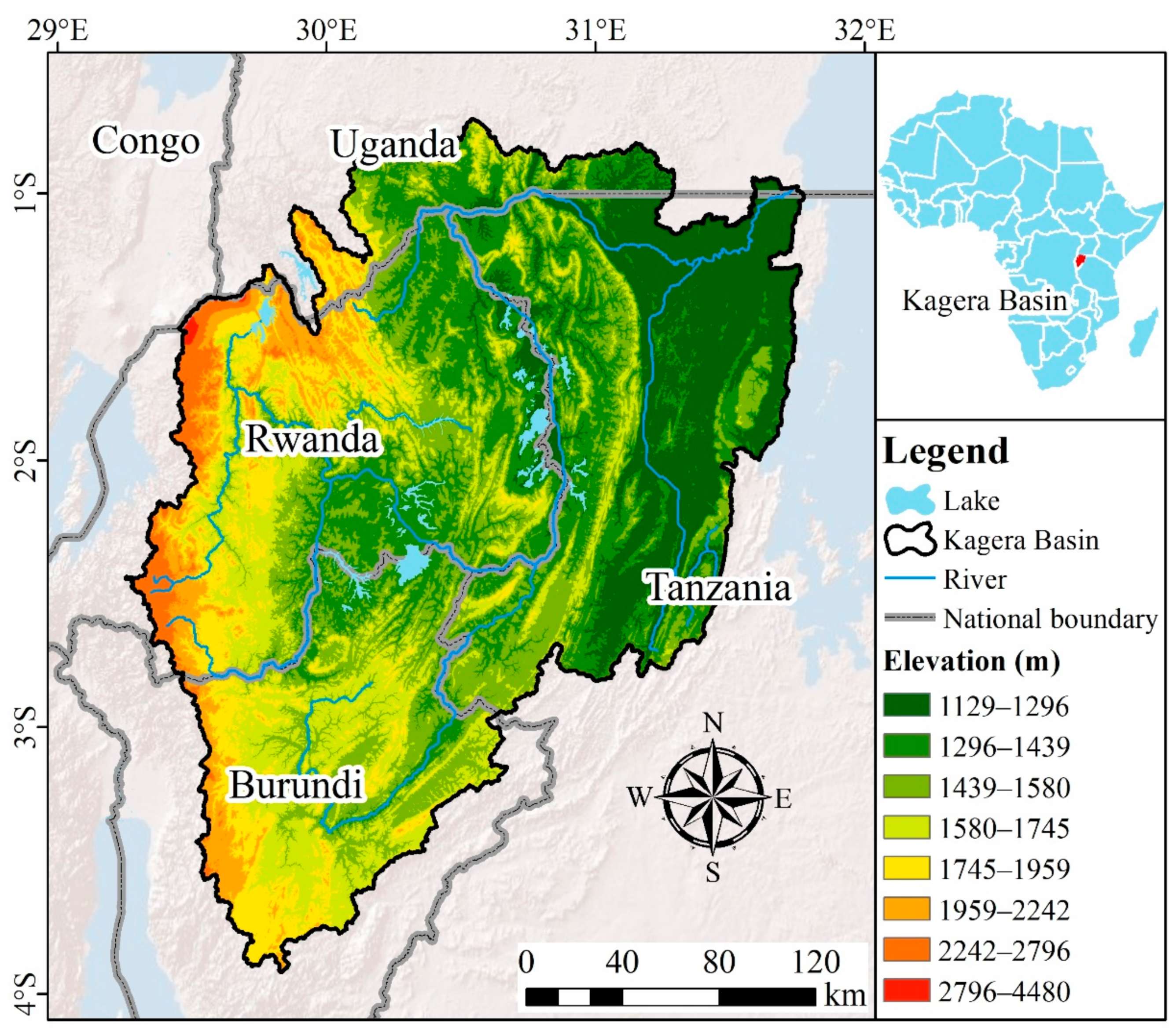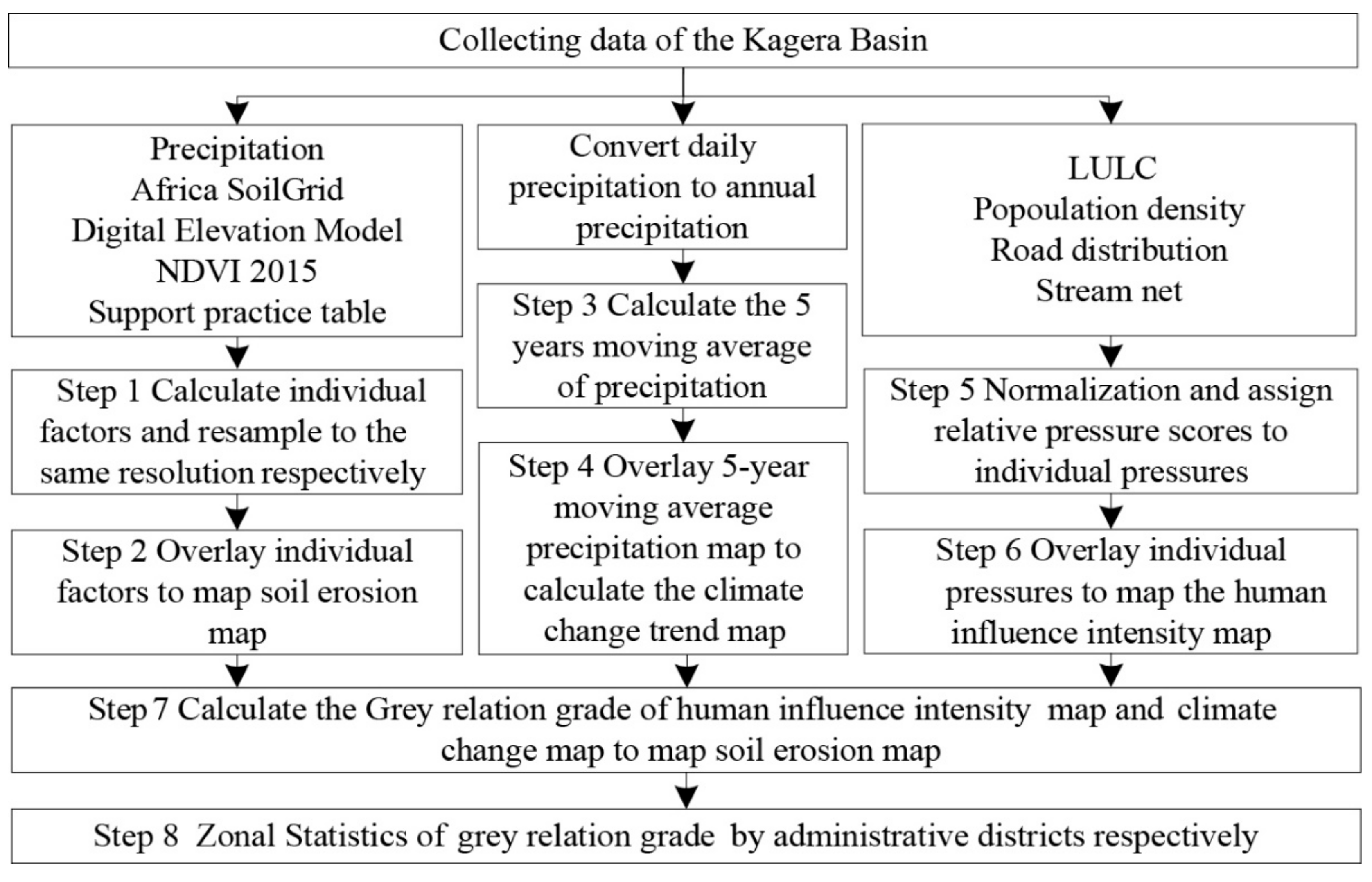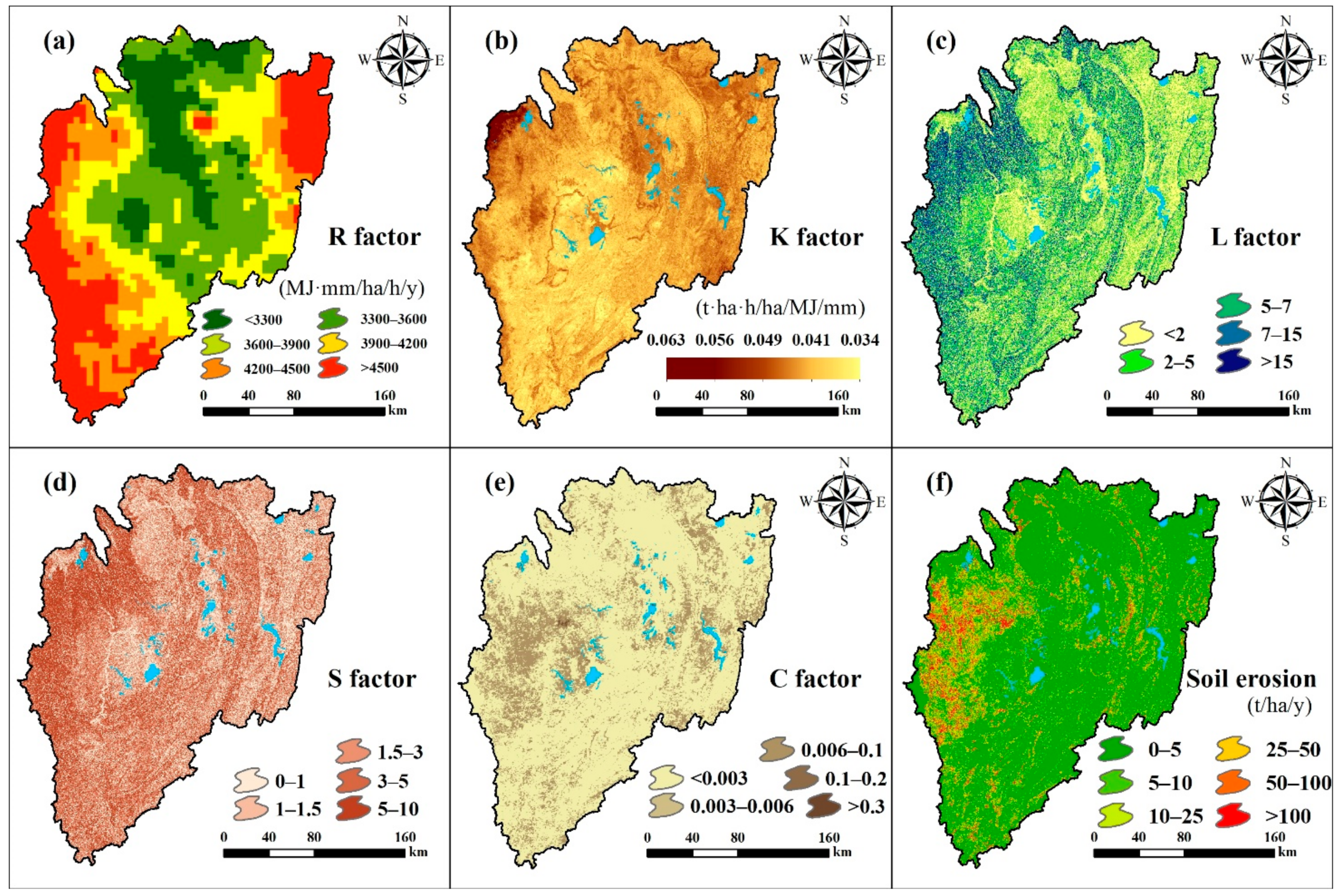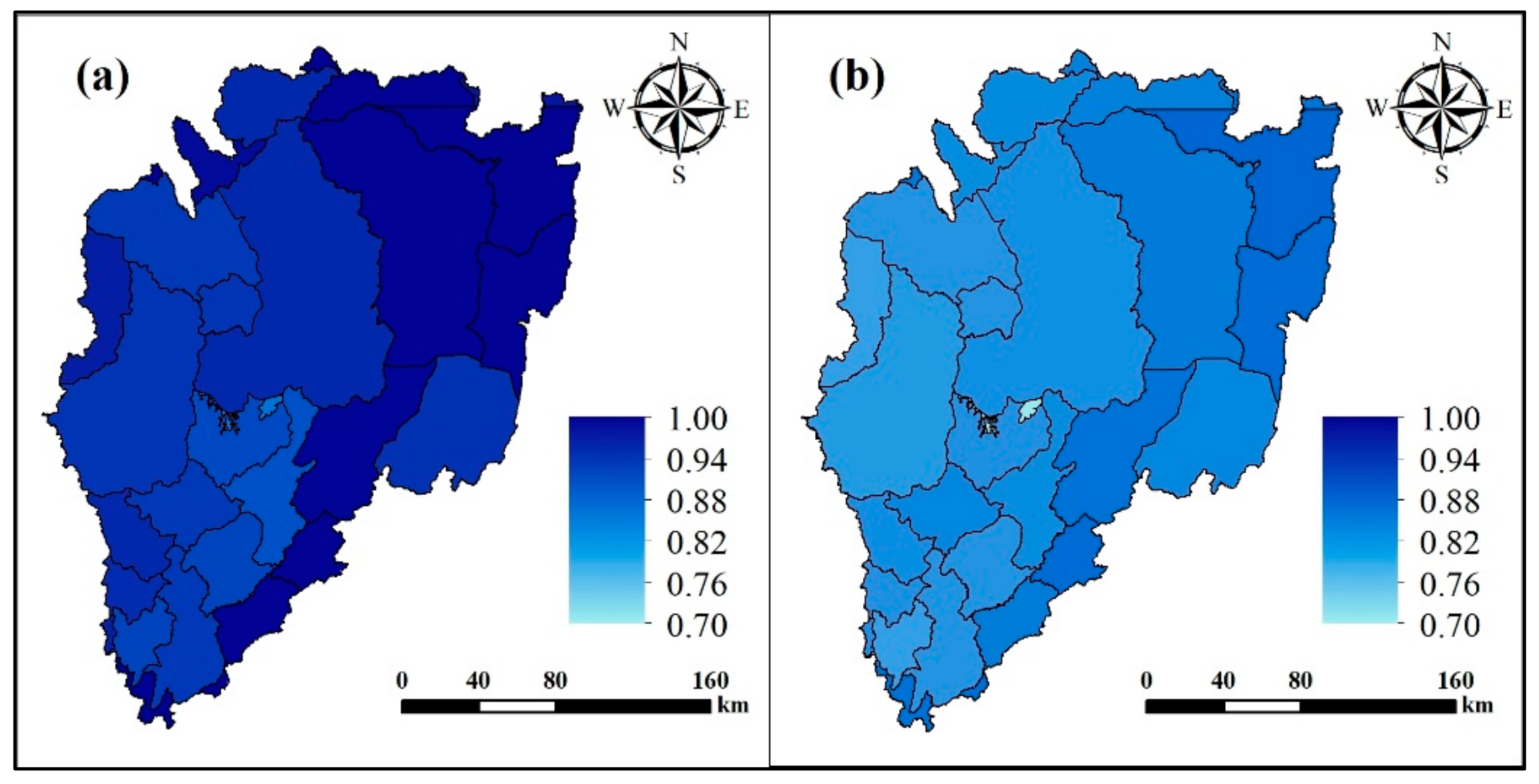Grid-Scale Impact of Climate Change and Human Influence on Soil Erosion within East African Highlands (Kagera Basin)
Abstract
1. Introduction
2. Materials and Methods
2.1. Study Area
2.2. Overview of the Employed Methods
2.3. Data Sources and Calculating Method
2.3.1. Data Sources
2.3.2. Development of the RUSLE Model
2.3.3. Climate Change Trend Analyses
2.3.4. Mapping the Human Influence Intensity
Land Use/Land Cover (LULC)
Population Density
Accessibility
2.3.5. Grey Relation Analysis (GRA)
3. Results
3.1. Soil Erosion in the Kagera Basin
3.2. Climate Change Trends in the KB
3.3. Human Influence Intensity in the KB
3.4. Impact of Climate Change and Human Influence on Soil Erosion
4. Discussion
4.1. Major Factors Influencing Soil Erosion
4.2. Previous Studies
4.3. Uncertainty Analysis
5. Conclusions
Author Contributions
Funding
Institutional Review Board Statement
Informed Consent Statement
Data Availability Statement
Conflicts of Interest
References
- Keesstra, S.; Mol, G.; De Leeuw, J.; Okx, J.; De Cleen, M.; Visser, S. Soil-related sustainable development goals: Four concepts to make land degradation neutrality and restoration work. Land 2018, 7, 133. [Google Scholar] [CrossRef]
- Bangash, R.F.; Passuello, A.; Sanchez-Canales, M.; Terrado, M.; López, A.; Elorza, F.J.; Ziv, G.; Acuña, V.; Schuhmacher, M. Ecosystem services in Mediterranean river basin: Climate change impact on water provisioning and erosion control. Sci. Total Environ. 2013, 458, 246–255. [Google Scholar] [CrossRef]
- Khoi, D.N.; Suetsugi, T. The responses of hydrological processes and sediment yield to land-use and climate change in the Be River Catchment, Vietnam. Hydrol. Process. 2014, 28, 640–652. [Google Scholar] [CrossRef]
- Lu, X.; Ran, L.; Liu, S.; Jiang, T.; Zhang, S.; Wang, J. Sediment loads response to climate change: A preliminary study of eight large Chinese rivers. Int. J. Sediment Res. 2013, 28, 1–14. [Google Scholar] [CrossRef]
- Wilson, C.O.; Weng, Q. Simulating the impacts of future land use and climate changes on surface water quality in the Des Plaines River watershed, Chicago Metropolitan Statistical Area, Illinois. Sci. Total Environ. 2011, 409, 4387–4405. [Google Scholar] [CrossRef] [PubMed]
- Guo, Y.; Peng, C.; Zhu, Q.; Wang, M.; Wang, H.; Peng, S.; He, H. Modelling the impacts of climate and land use changes on soil water erosion: Model applications, limitations and future challenges. J. Environ. Manag. 2019, 250, 109403. [Google Scholar] [CrossRef] [PubMed]
- Ligonja, P.J.; Shrestha, R.P. Soil erosion assessment in kondoa eroded area in Tanzania using universal soil loss equation, geographic information systems and socioeconomic approach. Land Degrad. Dev. 2015, 26, 367–379. [Google Scholar] [CrossRef]
- Wuepper, D.; Borrelli, P.; Finger, R. Countries and the global rate of soil erosion. Nat. Sustain. 2020, 3, 51–55. [Google Scholar] [CrossRef]
- Novara, A.; Pulido, M.; Rodrigo-Comino, J.; Di Prima, S.; Smith, P.; Gristina, L.; Keesstra, S. Long-term organic farming on a citrus plantation results in soil organic matter recovery. Cuad. De Investig. Geográfica 2019, 45, 271–286. [Google Scholar] [CrossRef]
- Nearing, M.A.; Pruski, F.F.; O’neal, M.R. Expected climate change impacts on soil erosion rates: A review. J. Soil Water Conserv. 2004, 59, 43–50. [Google Scholar] [CrossRef]
- Ziadat, F.M.; Taimeh, A.Y. Effect of rainfall intensity, slope, land use and antecedent soil moisture on soil erosion in an arid environment. Land Degrad. Dev. 2013, 24, 582–590. [Google Scholar] [CrossRef]
- Onet, A.; Dincă, L.C.; Grenni, P.; Laslo, V.; Teusdea, A.C.; Vasile, D.L.; Enescu, R.E.; Crisan, V.E. Biological indicators for evaluating soil quality improvement in a soil degraded by erosion processes. J. Soils Sediments 2019, 19, 2393–2404. [Google Scholar] [CrossRef]
- Seutloali, K.E.; Beckedahl, H.R. A review of road-related soil erosion: An assessment of causes, evaluation techniques and available control measures. Earth Sci. Res. J. 2015, 19, 73–80. [Google Scholar] [CrossRef]
- Wang, S.; Sun, B.; Li, C.; Li, Z.; Ma, B. Runoff and Soil Erosion on Slope Cropland: A Review. J. Resour. Ecol. 2018, 9, 461–470. [Google Scholar] [CrossRef]
- Zanuncio, A.J.V.; Monteiro, T.C.; Lima, J.T.; Andrade, H.B.; Carvalho, A.G. Drying biomass for energy use of Eucalyptus urophylla and Corymbia citriodora logs. BioResources 2013, 8, 5159–5168. [Google Scholar] [CrossRef]
- Ma, B.; Li, C.; Wang, B.; Mupenzi, C.; Nsanzabaganwa, J.; Hakorimana, E.; Zhang, J. Investigation Report on Soil Erosion in Mountain and Hilly Regions of Republic of Rwanda. Bull. Soil Water Conserv. 2019, 39, 281–287. (In Chinese) [Google Scholar]
- Teng, H.; Liang, Z.; Chen, S.; Liu, Y.; Rossel, R.A.V.; Chappell, A.; Yu, W.; Shi, Z. Current and future assessments of soil erosion by water on the Tibetan Plateau based on RUSLE and CMIP5 climate models. Sci. Total Environ. 2018, 635, 673–686. [Google Scholar] [CrossRef] [PubMed]
- de Hipt, F.O.; Diekkrüger, B.; Steup, G.; Yira, Y.; Hoffmann, T.; Rode, M. Modeling the impact of climate change on water resources and soil erosion in a tropical catchment in Burkina Faso, West Africa. Catena 2018, 163, 63–77. [Google Scholar] [CrossRef]
- Poulenard, J.; Podwojewski, P.; Janeau, J.L.; Collinet, J. Runoff and soil erosion under rainfall simulation of Andisols from the Ecuadorian Páramo: Effect of tillage and burning. Catena 2001, 45, 185–207. [Google Scholar] [CrossRef]
- Azimi Sardari, M.R.; Bazrafshan, O.; Panagopoulos, T.; Sardooi, E.R. Modeling the Impact of Climate Change and Land Use Change Scenarios on Soil Erosion at the Minab Dam Watershed. Sustainability 2019, 11, 3353. [Google Scholar] [CrossRef]
- Shrestha, S.; Sattar, H.; Khattak, M.S.; Wang, G.; Babur, M. Evaluation of adaptation options for reducing soil erosion due to climate change in the Swat River Basin of Pakistan. Ecol. Eng. 2020, 158, 106017. [Google Scholar] [CrossRef]
- Cai, Q. The Relationships between Soil Erosion and Human Activities on the Loess Plateau. Sustainable Utilization of Global Soil and Water Resources. Volume 1: Soil and Water Conservation Regional Policies and Action; Tsinghua University Press: Beijing, China, 2002. [Google Scholar]
- Smetanová, A.; Nunes, J.P.; Symeonakis, E.; Brevik, E.; Schindelwolf, M.; Ciampalini, R. Mapping and modelling soil erosion to address societal challenges in a changing world. Land Degrad. Dev. 2019, 31, 2519–2524. [Google Scholar] [CrossRef]
- Berakhi, R.O.; Oyana, T.J.; Adu-Prah, S. Land use and land cover change and its implications in Kagera river basin, East Africa. Afr. Geogr. Rev. 2015, 34, 209–231. [Google Scholar] [CrossRef]
- Nile Basin Initiative. Socio-Economic Development and Benefit Sharing Project (SDBS): Final Report; Council of Ministers of Water Affairs of the Nile Basin States: Addis Ababa, Ethiopia, 2009. [Google Scholar]
- Sanderson, E.W.; Jaiteh, M.; Levy, M.A.; Redford, K.H.; Wannebo, A.V.; Woolmer, G. The human footprint and the last of the wild. BioScience 2002, 52, 891–904. [Google Scholar] [CrossRef]
- Funk, C.; Peterson, P.; Landsfeld, M.; Pedreros, D.; Verdin, J.; Shukla, S.; Husak, G.; Rowland, J.; Harrison, L.; Hoell, A.; et al. The climate hazards infrared precipitation with stations—A new environmental record for monitoring extremes. Sci. Data 2015, 2, 1–21. [Google Scholar] [CrossRef]
- Hengl, T.; Heuvelink, G.B.; Kempen, B.; Leenaars, J.G.; Walsh, M.G.; Shepherd, K.D.; Sila, A.; MacMillan, R.A.; Mendes de Jesus, J.; Tamene, L.; et al. Mapping soil properties of Africa at 250 m resolution: Random forests significantly improve current predictions. PLoS ONE 2015, 10, e0125814. [Google Scholar] [CrossRef]
- Didan, K. MOD13A1 MODIS/Aqua Vegetation Indices 16-Day L3 Global 500m SIN Grid V006; NASA: Tucson, AZ, USA, 2015. [CrossRef]
- Friedl, M.; Sulla-Menashe, D. MCD12Q1 MODIS/Terra+ Aqua Land Cover Type Yearly L3 Global 500m SIN Grid V006; NASA: Tucson, AZ, USA, 2015. [CrossRef]
- IGBP. The International Geosphere–Biosphere Programme: A Study of Global Change. In IGBP Global Change Report; IGBP: Stockholm, Sweden, 1990. [Google Scholar]
- Tatem, A. WorldPop, open data for spatial demography. Sci. Data 2017, 4, 170004. [Google Scholar] [CrossRef]
- Hamilton, S. Rivers, Lake Victoria Watershed, vector line, 2000. Harv. Dataverse 2016, V3. [Google Scholar] [CrossRef]
- Wischmeier, W.H.; Smith, D.D. Predicting rainfall erosion losses: A guide to conservation Planning. United States Department of Agriculture (USDA). In Agricultural Research Service, Handbook No.537; United States Government Printing Office: Washington, DC, USA, 1978. [Google Scholar]
- Lo, A.; El-Swaify, S.A.; Dangler, E.W.; Shinshiro, L. Effectiveness of EI Sub (30) as an Erosivity Index in Hawaii; Soil Conservation Society of America: Ankeny, IA, USA, 1985. [Google Scholar]
- Williams, J.R.; Renard, K.G.; Dyke, P.T. EPIC: A new method for assessing erosion’s effect on soil productivity. J. Soil Water Conserv. 1983, 38, 381–383. [Google Scholar] [CrossRef]
- Renard, K.G. Predicting Soil Erosion by Water: A Guide to Conservation Planning with the Revised Universal Soil Loss Equation (RUSLE); United States Government Printing: Washington, DC, USA, 1997.
- McCool, D.K.; Brown, L.C.; Foster, G.R.; Mutchler, C.K.; Meyer, L.D. Revised slope steepness factor for the Universal Soil Loss Equation. Trans. ASABE 1987, 30, 1387–1396. [Google Scholar] [CrossRef]
- Van Leeuwen, W.J.; Sammons, G. Vegetation dynamics and erosion modeling using remotely sensed data (MODIS) and GIS. In Proceedings of the Tenth Biennial USDA Forest Service Remote Sensing Applications Conference, Salt Lake City, UT, USA, 5–9 April 2004. [Google Scholar]
- Van der Knijff, J.M.; Jones, R.J.A.; Montanarella, L. Soil Erosion Risk: Assessment in Europe. European Soil Bureau; European Commission: Brussels, Belgium, 2000. [Google Scholar]
- Saiz, G.; Wandera, F.M.; Pelster, D.E.; Ngetich, W.; Okalebo, J.R.; Rufino, M.C.; Butterbach-Bahl, K. Long-term assessment of soil and water conservation measures (Fanya-juu terraces) on soil organic matter in South Eastern Kenya. Geoderma 2016, 274, 1–9. [Google Scholar] [CrossRef]
- Sen, P.K. Estimates of the regression coefficient based on Kendall’s tau. J. Am. Stat. Assoc. 1968, 63, 1379–1389. [Google Scholar] [CrossRef]
- Mann, H.B. Nonparametric tests against trend. Econometrica 1945, 13, 245–259. [Google Scholar] [CrossRef]
- Kendall, M.G. Rank Correlation Methods; Griffin: London, UK, 1975. [Google Scholar]
- Vitousek, P.M.; Mooney, H.A.; Lubchenco, J.; Melillo, J.M. Human domination of Earth’s ecosystems. Science 1997, 277, 494–499. [Google Scholar] [CrossRef]
- Prins, H.H. Nature conservation as an integral part of optimal land use in East Africa: The case of the Masai Ecosystem of northern Tanzania. Biol. Conserv. 1987, 40, 141–161. [Google Scholar] [CrossRef]
- Maitima, J.M.; Mugatha, S.M.; Reid, R.S.; Gachimbi, L.N.; Majule, A.; Lyaruu, H.; Pomery, D.; Mathai, S.; Mugisha, S. The linkages between land use change, land degradation and biodiversity across East Africa. Afr. J. Environ. Sci. Technol. 2009, 3, 310–325. [Google Scholar]
- Li, S.; Zhang, Y.; Wang, Z.; Li, L. Mapping human influence intensity in the Tibetan Plateau for conservation of ecological service functions. Ecosyst. Serv. 2018, 30, 276–286. [Google Scholar] [CrossRef]
- Harcourt, A.H.; Parks, S.A.; Woodroffe, R. Human density as an influence on species/area relationships: Double jeopardy for small African reserves? Biodivers. Conserv. 2001, 10, 1011–1026. [Google Scholar] [CrossRef]
- Parks, S.A.; Harcourt, A.H. Reserve Size, Local Human Density, and Mammalian Extinctions in U.S. Protected Areas. Conserv. Biol. 2002, 16, 800–808. [Google Scholar] [CrossRef]
- Cardillo, M.; Purvis, A.; Sechrest, W.; Gittleman, J.L.; Bielby, J.; Mace, G.M. Human population density and extinction risk in the world’s carnivores. PLoS Biol. 2004, 2, e197. [Google Scholar] [CrossRef] [PubMed]
- United Nations Department for Economic Social Affairs. World Population Prospects 2019; Highlights: New York, NY, USA, 2019. [Google Scholar]
- Chidamba, L.; Korsten, L. Pyrosequencing analysis of roof-harvested rainwater and river water used for domestic purposes in Luthengele village in the Eastern Cape Province of South Africa. Environ. Monit. Assess. 2015, 187, 41. [Google Scholar] [CrossRef][Green Version]
- Kleinschroth, F.; Healey, J.R.; Sist, P.; Mortier, F.; Gourlet Fleury, S. How persistent are the impacts of logging roads on Central African forest vegetation? J. Appl. Ecol. 2016, 53, 1127–1137. [Google Scholar] [CrossRef]
- Malcolm, J.R.; Ray, J.C. Influence of timber extraction routes on central African small-mammal communities, forest structure, and tree diversity. Conserv. Biol. 2000, 14, 1623–1638. [Google Scholar] [CrossRef]
- Deng, J.L. Control problems of grey systems. Syst. Control Lett. 1982, 1, 288–294. [Google Scholar] [CrossRef]
- Winarni, S.; Indratno, S.W. Application of multi response optimization with grey relational analysis and fuzzy logic method. J. Phys. 2018, 948, 012075. [Google Scholar] [CrossRef]
- Asmamaw, L.B.; Mohammed, A.A. Identification of soil erosion hotspot areas for sustainable land management in the Gerado catchment, North-eastern Ethiopia. Remote Sens. Appl. Soc. Environ. 2019, 13, 306–317. [Google Scholar] [CrossRef]
- Karamage, F.; Zhang, C.; Kayiranga, A.; Shao, H.; Fang, X.; Ndayisaba, F.; Nahayo, L.; Mupenzi, C.; Tian, G. Usle-based assessment of soil erosion by water in the Nyabarongo River Catchment, Rwanda. Int. J. Environ. Res. Public Health 2016, 13, 835. [Google Scholar] [CrossRef] [PubMed]
- Karamage, F.; Zhang, C.; Fang, X.; Liu, T.; Ndayisaba, F.; Nahayo, L.; Kayiranga, A.; Baptiste Nsengiyumva, J. Modeling Rainfall-Runoff Response to Land Use and Land Cover Change in Rwanda (1990–2016). Water 2017, 9, 147. [Google Scholar] [CrossRef]
- Uwimbabazi, P.; Lawrence, R. Compelling factors of urbanization and rural-urban migration in Rwanda. Rwanda J. 2011, 22, 9–26. [Google Scholar] [CrossRef]
- Zhang, L.; Gao, Z.; Tian, H. Soil erosion process of engineering accumulation in steep slope under simulated runoff conditions. Trans. Chin. Soc. Agric. Eng. 2013, 29, 145–153. (In Chinese) [Google Scholar]
- Zuo, D.; Xu, Z.; Yao, W.; Jin, S.; Xiao, P.; Ran, D. Assessing the effects of changes in land use and climate on runoff and sediment yields from a watershed in the Loess Plateau of China. Sci. Total Environ. 2016, 544, 238–250. [Google Scholar] [CrossRef]
- López-Moreno, J.I.; Zabalza, J.; Vicente-Serrano, S.M.; Revuelto, J.; Gilaberte, M.; Azorin-Molina, C.; Morán-Tejeda, E.; García-Ruiz, J.M.; Tague, C. Impact of climate and land use change on water availability and reservoir management: Scenarios in the Upper Aragón River, Spanish Pyrenees. Sci. Total Environ. 2014, 493, 1222–1231. [Google Scholar] [CrossRef]
- Borrelli, P.; Robinson, D.A.; Fleischer, L.R.; Lugato, E.; Ballabio, C.; Alewell, C.; Meusburger, K.; Modugno, S.; Schütt, B.; Ferro, V.; et al. An assessment of the global impact of 21st century land use change on soil erosion. Nat. Commun. 2017, 8, 1–13. [Google Scholar] [CrossRef] [PubMed]
- Serpa, D.; Nunes, J.P.; Santos, J.; Sampaio, E.; Jacinto, R.; Veiga, S.; Lima, J.C.; Moreira, M.; Corte-Real, J.; Keizer, J.J.; et al. Impacts of climate and land use changes on the hydrological and erosion processes of two contrasting Mediterranean catchments. Sci. Total Environ. 2015, 538, 64–77. [Google Scholar] [CrossRef]
- Nunes, J.P.; Jacinto, R.; Keizer, J.J. Combined impacts of climate and socio-economic scenarios on irrigation water availability for a dry Mediterranean reservoir. Sci. Total Environ. 2017, 584, 219–233. [Google Scholar] [CrossRef]
- Ellis-Jones, J.; Tengberg, A. The impact of indigenous soil and water conservation practices on soil productivity: Examples from Kenya, Tanzania and Uganda. Land Degrad. Dev. 2000, 11, 19–36. [Google Scholar] [CrossRef]
- Liniger, H.; Mekdaschi, R.; Hauert, C.; Gurtner, M. Sustainable Land Management in Practice: Guidelines and Best Practices for Sub-Saharan Africa; FAO: Rome, Italy, 2011. [Google Scholar]
- Siriri, D.; Wilson, J.; Coe, R.; Tenywa, M.M.; Bekunda, M.A.; Ong, C.K.; Black, C.R. Trees improve water storage and reduce soil evaporation in agroforestry systems on bench terraces in SW Uganda. Agrofor. Syst. 2013, 87, 45–58. [Google Scholar] [CrossRef]
- Runezerwa, A.B. Farmers, Institutions and Land Conservation: Institutional Economic Analysis of Bench Terraces in the Highlands of Rwanda; Wageningen University: Wageningen, The Netherlands, 2011. [Google Scholar]
- Rwanda Agriculture Board. Annual Report 2012–2013; RAB: Kigali, Rwanda, 2012. [Google Scholar]
- Reuter, M.; Piller, W.E.; Harzhauser, M.; Berning, B.; Kroh, A. Sedimentary evolution of a late Pleistocene wetland indicating extreme coastal uplift in southern Tanzania. Quat. Res. 2010, 73, 136–142. [Google Scholar] [CrossRef]
- Materu, S.T. Assessment of improved ladder terraces in controlling soil erosion on Uluguru Mountains-Tanzania. J. Agric. Sci. 2016, 8. [Google Scholar] [CrossRef]
- Beekman, G.; Bulte, E.H. Social norms, tenure security and soil conservation: Evidence from Burundi. Agric. Syst. 2012, 108, 50–63. [Google Scholar] [CrossRef]
- Ndagijimana, M.; Kessler, A.; Asseldonk, M.V. Understanding farmers’ investments in sustainable land management in Burundi: A case-study in the provinces of Gitega and Muyinga. Land Degrad. Dev. 2019, 30, 417–425. [Google Scholar] [CrossRef]
- World Health Organization. Safely Managed Drinking Water-Thematic Report on Drinking Water 2017; World Health Organization: Geneva, Switzerland, 2017. [Google Scholar]
- Novara, A.; Cerda, A.; Barone, E.; Gristina, L. Cover crop management and water conservation in vineyard and olive orchards. Soil Tillage Res. 2021, 208, 104896. [Google Scholar] [CrossRef]
- Rodrigo-Comino, J.; Terol, E.; Mora, G.; Giménez-Morera, A.; Cerdà, A. Vicia sativa Roth. Can Reduce Soil and Water Losses in Recently Planted Vineyards (Vitis vinifera L.). Earth Syst. Environ. 2020, 4, 827–842. [Google Scholar] [CrossRef]








| No. | LULC | Descriptions | Score |
|---|---|---|---|
| 1 | Evergreen broadleaf forests | Lands dominated by broadleaf woody vegetation with a percent cover > 60% and height exceeding 2 m. | 0 |
| 2 | Closed shrub-land | Lands with woody vegetation less than 2 m tall and with shrub canopy cover > 60%. | 0 |
| 3 | Open shrub-land | Lands with woody vegetation less than 2 m tall and with shrub canopy cover between 10 and 60%. | 1 |
| 4 | Woody savannas | Lands with herbaceous and other understory systems, and with forest canopy cover between 30 and 60%. The forest cover height exceeds 2 m. | 1 |
| 5 | Savannas | Lands with herbaceous and other understory systems, and with forest canopy cover between 10 and 30%. The forest cover height exceeds 2 m. | 1 |
| 6 | Grasslands | Lands with herbaceous types of cover. Tree and shrub cover together are less than 10%. | 2 |
| 7 | Permanent wetlands | Lands with a permanent mixture of water and herbaceous or woody vegetation. | 1 |
| 8 | Croplands | Lands covered with temporary crops followed by harvest and a bare soil period. | 8 |
| 9 | Urban and built-up lands | Land covered by buildings and other man-made structures. | 10 |
| 10 | Cropland/natural vegetation mosaic | Lands with a mosaic of croplands, forests, shrub-land, and grasslands in which no individual component comprises more than 60% of the landscape. | 6 |
| 11 | Water bodies | Lakes, reservoirs, and rivers. Can be either fresh or saltwater bodies. | 0 |
| Type | 0–1 km | 1–5 km | 5–10 km | 10–15 km | |
|---|---|---|---|---|---|
| Roads | Paved | 10 | 8 | 7 | 4 |
| Unpaved | 6 | 4 | 2 | 1 | |
| Waterways | 5 | 2 | |||
| Classes of the Soil Erosion | ||||||
|---|---|---|---|---|---|---|
| Severity Classes | Very Low | Low | Moderate | High | Very High | Severe |
| Soil loss (t ha−1 yr−1) | 0–5 | 5–10 | 10–25 | 25–50 | 50–100 | >100 |
| Area (%) | 75.14 | 7.42 | 2.12 | 8.16 | 4.41 | 2.75 |
| LULC Type after Reclassification | Original IGBP LULC Type |
|---|---|
| Forest | Evergreen broadleaf forests |
| Rangeland | Closed shrub-land |
| Open shrub-land | |
| Woody savannas | |
| Savannas | |
| Grasslands | |
| Wetland | Permanent wetlands |
| Farmland | Croplands |
| Cropland/natural vegetation mosaic | |
| Built-up | Urban and built-up lands |
| Water | Water bodies |
| LULC Types | Soil Erosion Rate (t ha−1 yr−1) | Soil Loss (%) | Area | |
|---|---|---|---|---|
| (%) | (km2) | |||
| Forest | 0.71 | 0.08 | 1.22 | 698.25 |
| Rangeland | 8.51 | 49.60 | 61.35 | 35,071.75 |
| Wetland | 11.77 | 1.87 | 1.67 | 957.50 |
| Farmland | 13.61 | 45.97 | 35.56 | 20,330.50 |
| Built-up | 132.43 | 2.48 | 0.20 | 112.75 |
Publisher’s Note: MDPI stays neutral with regard to jurisdictional claims in published maps and institutional affiliations. |
© 2021 by the authors. Licensee MDPI, Basel, Switzerland. This article is an open access article distributed under the terms and conditions of the Creative Commons Attribution (CC BY) license (http://creativecommons.org/licenses/by/4.0/).
Share and Cite
Li, C.; Li, Z.; Yang, M.; Ma, B.; Wang, B. Grid-Scale Impact of Climate Change and Human Influence on Soil Erosion within East African Highlands (Kagera Basin). Int. J. Environ. Res. Public Health 2021, 18, 2775. https://doi.org/10.3390/ijerph18052775
Li C, Li Z, Yang M, Ma B, Wang B. Grid-Scale Impact of Climate Change and Human Influence on Soil Erosion within East African Highlands (Kagera Basin). International Journal of Environmental Research and Public Health. 2021; 18(5):2775. https://doi.org/10.3390/ijerph18052775
Chicago/Turabian StyleLi, Chaodong, Zhanbin Li, Mingyi Yang, Bo Ma, and Baiqun Wang. 2021. "Grid-Scale Impact of Climate Change and Human Influence on Soil Erosion within East African Highlands (Kagera Basin)" International Journal of Environmental Research and Public Health 18, no. 5: 2775. https://doi.org/10.3390/ijerph18052775
APA StyleLi, C., Li, Z., Yang, M., Ma, B., & Wang, B. (2021). Grid-Scale Impact of Climate Change and Human Influence on Soil Erosion within East African Highlands (Kagera Basin). International Journal of Environmental Research and Public Health, 18(5), 2775. https://doi.org/10.3390/ijerph18052775






